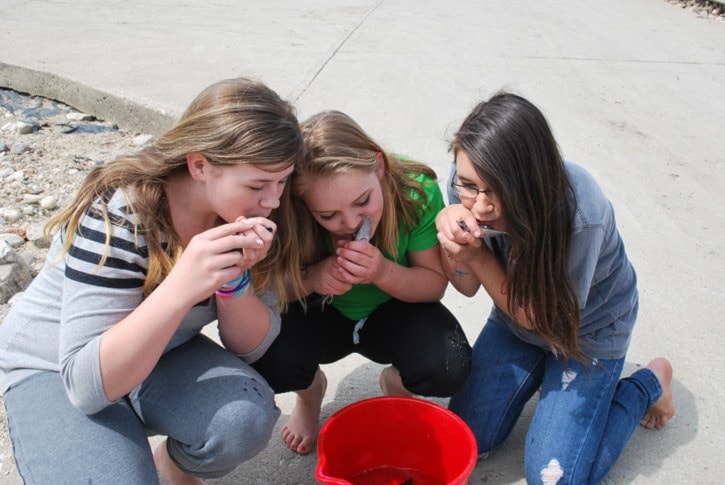Angus Glass was worried. The big yellow school bus jammed full of Nakusp Secondary kids was ready to cart its child-contents over to Shelter Bay and spill them onto the handful of volunteers running the sturgeon release program, but the ferry wasn’t looking up to the challenge.
Running the smaller Shelter Bay Ferry in place of the regular Galena Bay meant there just wasn’t enough space on board for a big bus. So, off flooded the kids from the bus and on to the ferry, filling up the spaces between vehicles and bewildering drivers.
Glass, Communications Coordinator for the Fish and Wildlife Compensation Program, was just one of the many people involved in the sturgeon release, an annual program that sees over six thousand juvenile sturgeon get released into the Upper Arrow Lakes Reservoir on a single day. This year, volunteers from the Revelstoke Rod and Gun Club helped BC Hydro and FWCP’s efforts wrangling fish and kids as part of a public awareness campaign.
The NSS students are bit older than average, which worried Glass too, who fretted that they may be a bit too old to be inspired with wonder and awe at the sight of a dinosaur-like fish. The element of childlike wonder is what he and other conservation-minded folks hope will stick with kids, in turn creating future conservation-minded adult members of society.
Julia Flesaker’s grade eight students from NSS made up the first group, and two more classes were due to arrive from Revelstoke around noon. Just in advance of them, the fish trucks transporting the bony grey fish arrived at the Shelter Bay site. In order to get their aquatic cargo there on time, the drivers had been up and on the road in the wee hours that same day, Glass told the Arrow Lakes News. The sturgeon were fine in their aerated tanks for up to 12 hours, but much of that was taken up by five hours of transportation time.
When the lid came off the truck’s tank, the kids crowded around, jostling for a spot to watch the bony grey sturgeon swimming about in their mobile home, looking awed and filled with wonder already.
Due to low “natural recruitment” – survival between egg and juvenile stage in the natural environment – the sturgeon are released when they are ten months old and have a better chance of survival. Why natural recruitment in the fish is so low is still unknown to biologists, Glass said, who pointed to many factors like temperature, turbidity and predation that can affect survival rates. Construction of hydroelectric dams has been seen as one of the factors that has led to the fish’s decline, and this program is one of BC Hydro’s efforts to mitigate the effects of dams.
Currently, it is estimated that there around 50 white sturgeon in Upper Arrow Lakes Reservoir, and 1,100 wild fish in the Canadian waters south of Castlegar. These sturgeon can live for more than 100 years, reaching reproductive maturity at 20, give or take five years. Because of their mature breeding age, it’s hard to tell at this point what impact the release program is having, as it’s only in its eleventh year.
With red plastic buckets of sturgeon in hand, students and volunteers headed down to the shore ready to move these fish into their new Upper Arrow Lakes home. Each fish was outfitted with a small PIT (Passive Integrated Transponder) tag about the size of a grain of rice. Picking a fish, each student held it up to a scanner, which was a lot like a price check scanner you’d find in your local supermarket, that read the number before they place their fish gently into the shallow water. The releaser then got a card with their fish’s tag number on it, making it their own special fish being released out into the lake.
Angus Glass really needn’t have worried about the kids having reached the old and jaded age of thirteen and being underwhelmed by prehistoric-looking fish. They loved it. In fact, some students loved it so much they kissed their fish before releasing them into the lake.
“They’re really bony,” said one girl, obviously intrigued and not grossed out by the experience. “It feels like you’re holding on to a spine.”
After a longer than normal wait for the Shelter Bay Ferry, the little ferry that could, the Grade Eights once again meandered through the ferry traffic, up the slope to the other side and back into their big old bus. Exhausted from fish magic and sun, I bet there was more than one that dozed a little on the ride back into town.
